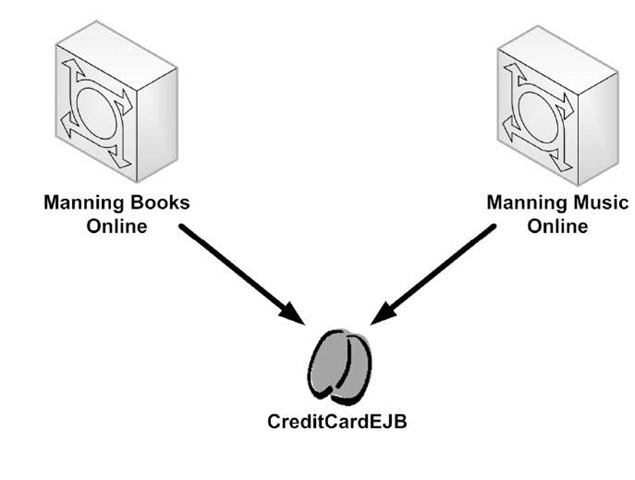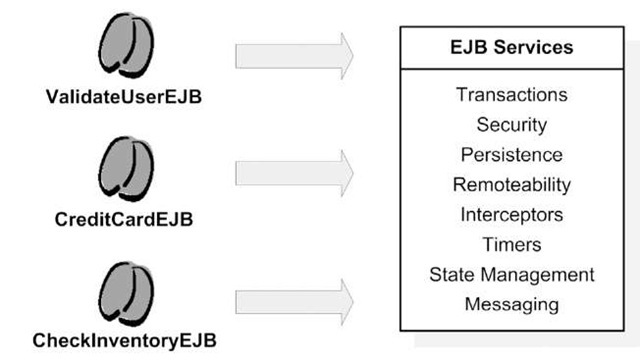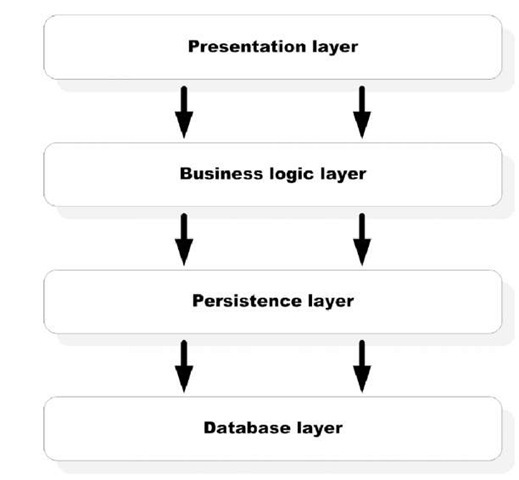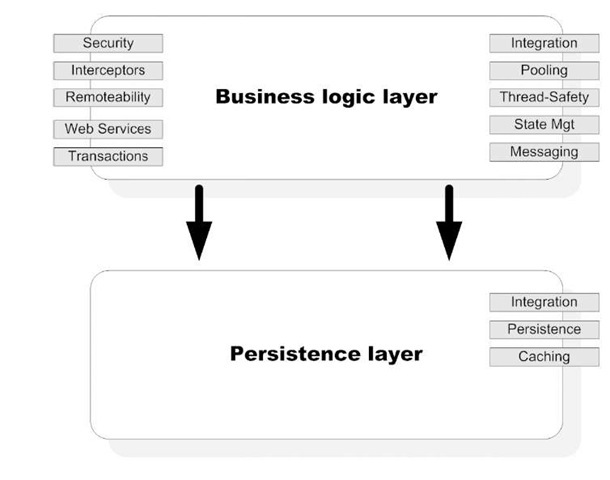In very straightforward terms, Enterprise JavaBeans (EJB) is a platform for building portable, reusable, and scalable business applications using the Java programming language. Since its initial incarnation, EJB has been touted as a component model or framework that lets you build enterprise Java applications without having to reinvent services such as transactions, security, automated persistence, and so on that you may need for building an application. EJB allows application developers to focus on building business logic without having to spend time on building infrastructure code.
From a developer’s point of view, an EJB is a piece of Java code that executes in a specialized runtime environment called the EJB container, which provides a number of component services. The persistence services are provided by a specialized framework called the persistence provider. We’ll talk more about the EJB container, persistence provider, and services in section 1.3.
In this section, you’ll learn how EJB functions as both a component and a framework. We’ll also examine how EJB lends itself to building layered applications. We’ll round off this section by listing a few reasons why EJB might be right for you.
EJB as a component
In this topic, when we talk about EJBs, we are referring to the server-side components that you can use to build parts of your application, such as the business logic or persistence code. Many of us tend to associate the term component with developing complex and heavyweight CORBA, Microsoft COM+ code. In the brave new world of EJB 3, a component is what it ought to be—nothing more than a POJO with some special powers. More importantly, these powers remain invisible until they are needed and don’t distract from the real purpose of the component.
The real idea behind a component is that it should effectively encapsulate application behavior. The users of a component aren’t required to know its inner workings. All they need to know is what to pass in and what to expect back.
There are three types of EJB components: session beans, message-driven beans, and entities. Session beans and message-driven beans are used to implement business logic in an EJB application, and entities are used for persistence.
Components can be reusable. For instance, suppose you’re in charge of building a website for an online merchant that sells technology books. You implement a module to charge the credit card as part of a regular Java object. Your company does fairly well, and you move on to greener pastures. The company then decides to diversify and begins developing a website for selling CDs and DVDs. Since the deployment environment for the new site is different, it can’t be located on the same server as your module. The person building the new site is forced to duplicate your credit card module in the new website because there’s no easy way to access your module. If you had instead implemented the credit card-charging module as an EJB component as shown in figure 1.1 (or as a web service), it would have been much easier for the new person to access it by simply making a call to it when she needed that functionality. She could have reused it without having to understand its implementation.
Given that, building a reusable component requires careful planning because, across enterprise applications within an organization, very little of the business logic may be reusable. Therefore, you may not care about the reusability of EJB components, but EJB still has much to offer as a framework, as you’ll discover in the next section.
Figure 1.1 EJB allows development of reusable components. For example, you can implement the credit card-charging module as an EJB component that may be accessed by multiple applications.
EJB as a framework
As we mentioned, EJB components live in a container. Together, the components, or EJBs, and the container can be viewed as a framework that provides valuable services for enterprise application development.
Although many people think EJBs are overkill for developing relatively simple web applications of moderate size, nothing could be further from the truth. When you build a house, you don’t build everything from scratch. Instead, you buy materials or even the services of a contractor as you need it. It isn’t too practical to build an enterprise application from scratch either. Most server-side applications have a lot in common, including churning business logic, managing application state, storing and retrieving information from a relational database, managing transactions, implementing security, performing asynchronous processing, integrating systems, and so on.
As a framework, the EJB container provides these kinds of common functionality as out-of-the-box services so that your EJB components can use them in your applications without reinventing the wheel. For instance, let’s say that when you built the credit card module in your web application, you wrote a lot of complex and error-prone code to manage transactions and security access control. You could have avoided that by using the declarative transaction and security services provided by the EJB container. These services, as well as many others you’ll learn about in section 1.3, are available to the EJB components when they are deployed in the EJB container, as you can see in figure 1.2. This means writing high-quality, feature-rich applications much faster than you might think.
The container provides the services to the EJB components in a rather elegant new way: metadata annotations are used to pre-configure the EJBs by specifying the type of services to add when the container deploys the EJBs. Java 5 introduced metadata annotations, which are property settings that mark a piece of code, such as a class or method, as having particular attributes. This is a declarative style of programming, in which the developer specifies what should be done and the system adds the code to do it.
Figure 1.2 EJB as a framework provides services to EJB components.
In EJB, metadata annotations dramatically simplify development and testing of applications, without having to depend on an external XML configuration file. It allows developers to declaratively add services to EJB components as and when they need. As figure 1.3 depicts, an annotation transforms a simple POJO into an EJB.
As you’ll learn, annotations are used extensively throughout EJB, and not only to specify services. For example, an annotation can be used to specify the type of the EJB component.
Although it’s sometimes easy to forget, enterprise applications have one more thing in common with a house. Both are meant to last, often much longer than anyone expects. Being able to support high-performance, fault-tolerant, scalable applications is an up-front concern for the EJB platform instead of being an afterthought. Not only will you be writing good server-side applications faster, but also you can expect your platform to grow with the success of your application. When the need to support a larger number of users becomes a reality, you won’t have to rewrite your code. Thankfully these concerns are taken care of by EJB container vendors. You’ll be able to count on moving your application to a distributed, clustered server farm by doing nothing more than a bit of configuration.
Last, but certainly not least, with a world that’s crazy about service-oriented architecture (SOA) and interoperability, EJB lets you turn your application into a web services powerhouse with ease when you need to.
The EJB framework is a standard Java technology with an open specification. If it catches your fancy, you can check out the real deal on the Java Community Process (JCP) website at www.jcp.org/en/jsr/detail?id=220. EJB is supported by a large number of companies and open source groups with competing but compatible implementations. On the one hand, this indicates that a large group of people will work hard to keep EJB competitive. On the other hand, the ease of portability means that you get to choose what implementation suits you best, making your application portable across EJB containers from different vendors.
Figure 1.3 EJBs are regular Java objects that may be configured using metadata annotations.
Now that we’ve provided a high-level introduction to EJB, let’s turn our attention to how EJB can be used to build layered applications.
Layered architectures and EJB
Most enterprise applications contain a large number of components. Enterprise applications are designed to solve a unique type of customer problem, but they share many common characteristics. For example, most enterprise applications have some kind of user interface and they implement business processes, model a problem domain, and save data into a database. Because of these commonalities, you can a follow a common architecture or design principle for building enterprise applications known as patterns.
For server-side development, the dominant pattern is layered architectures. In a layered architecture, components are grouped into tiers. Each tier in the application has a well-defined purpose, sort of like a profession but more like a section of a factory assembly line. Each section of the assembly line performs its designated task and passes the remaining work down the line. In layered architectures, each layer delegates work to a layer underneath it.
EJB allows you to build applications using two different layered architectures: the traditional four-tier architecture and domain-driven design (DDD). Let’s take a brief look at each of these architectures.
Traditional four-tier layered architecture
Figure 1.4 shows the traditional four-tier server architecture. This architecture is pretty intuitive and enjoys a wide popularity. In this architecture, the presentation layer is responsible for rendering the graphical user interface (GuI) and handling user input. The presentation layer passes down each request for application functionality to the business logic layer. The business logic layer is the heart of the application and contains workflow and processing logic. In other words, business logic layer components model distinct actions or processes the application can perform, such as billing, searching, ordering, and user account maintenance. The business logic layer retrieves data from and saves data into the database by utilizing the persistence tier. The persistence layer provides a high-level object-oriented (OO) abstraction over the database layer. The database layer typically consists of a relational database management system (RDBMS) like Oracle, DB2, or SQL Server.
Figure 1.4 Most traditional enterprise applications have at least four layers. 1) The presentation layer is the actual user interface and can either be a browser or a desktop application. 2) The business logic layer defines the business rules. 3) The persistence layer deals with interactions with the database. 4) The database layer consists of a relational database such as Oracle that stores the persistent objects.
EJB is obviously not a presentation layer technology. EJB is all about robust support for implementing the business logic and persistence layers. Figure 1.5 shows how EJB supports these layers via its services.
In section 1.3 we’ll go into more detail on EJB services. And in section 1.2 we’ll explore EJB bean types. For now, just note that the bean types called session beans and message-driven beans (MDBs) reside in and use the services in the business logic tier, and the bean types called entities reside in and use services in the persistence tier.
Figure 1.5 The component services offered by EJB 3 at each supported application layer. Note that each service is independent of the other, so you are for the most part free to pick the features important for your application. You’ll learn more about services in section 1.3.
The traditional four-tier layered architecture is not perfect. One of the most common criticisms is that it undermines the OO ideal of modeling the business domain as objects that encapsulate both data and behavior. Because the traditional architecture focuses on modeling business processes instead of the domain, the business logic tier tends to look more like a database-driven procedural application than an OO one. Since persistence-tier components are simple data holders, they look a lot like database record definitions rather than first-class citizens of the OO world. As you’ll see in the next section, DDD proposes an alternative architecture that attempts to solve these perceived problems.
Domain-driven design
The term domain-driven design (DDD) may be relatively new but the concept is not (see Domain-Driven Design: Tackling Complexity in the Heart of Software, by Eric Evans [Addison-Wesley Professional, 2003]). DDD emphasizes that domain objects should contain business logic and should not just be a dumb replica of database records. Domain objects are known as entities in EJB 3 (see section 1.2 for a discussion on entities). With DDD, the Catalog and Customer objects in a trading application are typical examples of entities, and they may contain business logic.
In his excellent book POJOs in Action (Manning, 2006), author Chris Richardson points out the problem in using domain objects just as a data holder.
Some developers still view persistent objects simply as a means to get data in and out of the database and write procedural business logic. They develop what Fowler calls an "anemic domain model"…. Just as anemic blood lacks vitality, anemic object models only superficially model the problem and consist of classes that implement little or no behavior.
Yet, even though its value is clear, until this release of EJB, it was difficult to implement DDD. Chris goes on to explain how EJB 2 encouraged procedural code:
… J2EE developers write procedural-style code [because] it is encouraged by the EJB architecture, literature, and culture, which place great emphasis on EJB components. EJB 2 components are not suitable for implementing an object model.
Admittedly, implementing a real domain model was almost impossible with EJB 2 because beans were not POJOs and did not support many OO features. such as inheritance and polymorphism. Chris specifically targets entity beans as the problem:
EJB 2 entity beans, which are intended to represent business objects, have numerous limitations that make it extremely difficult to use them to implement a persistent object model.
The good news is that EJB 3 enables you to easily follow good object-oriented design or DDD. The entities defined by EJB 3 Java Persistence API (JPA) support OO features, such as inheritance or polymorphism. It’s easy to implement a persistence object model with the EJB 3 JPA. More importantly, you can easily add business logic to your entities, so that implementing a rich domain model with EJB 3 is a trivial task.
Note, though, that many people don’t like adding complex business logic in the domain object itself and prefer creating a layer for procedural logic referred to as the service layer or application layer (see Patterns of Enterprise Application Architecture, by Martin Fowler [Addison-Wesley Professional, 2002]). The application layer is similar to the business logic layer of the traditional four-tier architecture, but is much thinner. Not surprisingly, you can use session beans to build the service layer. Whether you use the traditional four-tier architecture or a layered architecture with DDD, you can use entities to model domain objects, including modeling state and behavior.
Despite its impressive services and vision, EJB 3 is not the only act in town. You can combine various technologies to more or less match EJB services and infrastructure. For example, you could use Spring with other open source technologies such as Hibernate and Aspect J to build your application, so why choose EJB 3? Glad you asked…
Why choose EJB 3?
At the beginning of this topic, we hinted at EJB’s status as a pioneering technology. EJB is a groundbreaking technology that has raised the standards of server-side development. Just like Java itself, EJB has changed things in ways that are here to stay and inspired many innovations. In fact, up until a few years ago the only serious competition to EJB came from the Microsoft .NET framework.
In this section, we’ll point out a few of the compelling EJB 3 features that we feel certain will have this latest version at the top of your short list.
Ease of use
Thanks to the unwavering focus on ease of use, EJB 3 is probably the simplest server-side development platform around. The features that shine the brightest are POJO programming, annotations in favor of verbose XML, heavy use of sensible defaults, and JPA, all of which you will be learning about in this topic. Although the number of EJB services is significant, you’ll find them very intuitive. For the most part, EJB 3 has a practical outlook and doesn’t demand that you understand the theoretical intricacies. In fact, most EJB services are designed to give you a break from this mode of thinking so you can focus on getting the job done and go home at the end of the day knowing you accomplished something.
Integrated solution stack
EJB 3 offers a complete stack of server solutions, including persistence, messaging, lightweight scheduling, remoting, web services, dependency injection (DI), and interceptors. This means that you won’t have to spend a lot of time looking for third-party tools to integrate into your application. In addition, EJB 3 provides seamless integration with other Java EE technologies, such as JDBC, JavaMail, Java Transaction API JTA (JTA), Java Messaging Service (JMS), Java Authentication and Authorization Service (JAAS), Java Naming and Directory Interface (JNDI), Java Remote Method Invocation (RMI), and so on. EJB is also guaranteed to seamlessly integrate with presentation-tier technologies like JavaServer Pages (JSP), servlets, JavaServer Faces (JSF), and Swing.
Open Java EE standard
EJB is a critical part of the Java EE standard. This is an extremely important concept to grasp if you are to adopt EJB 3. EJB 3 has an open, public API specification, which organizations are encouraged to use to create a container or persistence provider implementation. The EJB 3 standard is developed by the Java Community Process (JCP), consisting of a nonexclusive group of individuals driving the Java standard. The open standard leads to broader vendor support for EJB 3, which means you don’t have to depend on a proprietary solution.
Broad vendor support
EJB is supported by a large and diverse variety of independent organizations. This includes the technology world’s largest, most respected, and most financially strong names, such as Oracle and IBM, as well as passionate and energetic open source groups like JBoss and Geronimo.
Wide vendor support translates to three important advantages for you. First, you are not at the mercy of the ups and downs of a particular company or group of people. Second, a lot of people have concrete long-term interests to keep the technology as competitive as possible. You can essentially count on being able to take advantage of the best-of-breed technologies both in and outside the Java world in a competitive timeframe. Third, vendors have historically competed against one another by providing value-added nonstandard features. All of these factors help keep EJB on the track of continuous healthy evolution.
Stable, high-quality code base
Although EJB 3 is a groundbreaking step, most application server implementations will still benefit from a relatively stable code base that has lived through some of the most demanding enterprise environments over a prolonged period of time. Most persistence provider solutions like JDO, Hibernate, and TopLink are also stable products that are being used in many mission-critical production environments. This means that although EJB 3 is very new, you can expect stable implementations relatively quickly. Also, because of the very nature of standards-based development, the quality of EJB 3 container implementations is generally not taken lightly by vendors. To some degree, this helps ensure a healthy level of inherent implementation quality.
Clustering, load balancing, and failover
Features historically added by most application server vendors are robust support for clustering, load balancing, and failover. EJB application servers have a proven track record of supporting some of the largest high-performance computing (HPC)-enabled server farm environments. More importantly, you can leverage such support with no changes to code, no third-party tool integration, and relatively simple configuration (beyond the inherent work in setting up a hardware cluster). This means that you can rely on hardware clustering to scale up your application with EJB 3 if you need to.
EJB 3 is a compelling option for building enterprise applications. In the following sections, we explain more about EJB types and how to use them. We also discuss containers and persistence providers and explore the services they provide. By the time you finish reading sections 1.2 and 1.3, you’ll have a good idea of what EJBs are and where they run, and what services they offer. So let’s get started!





